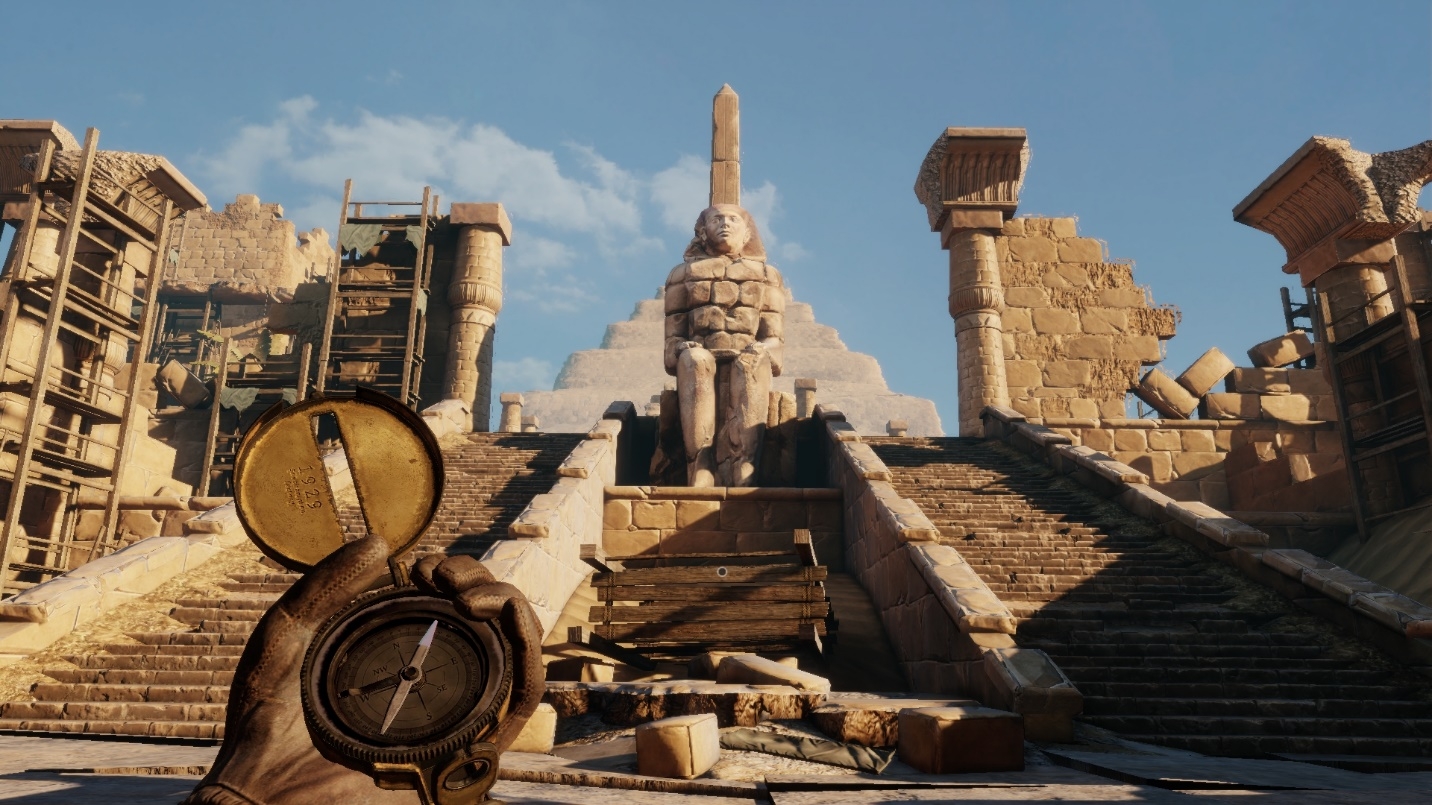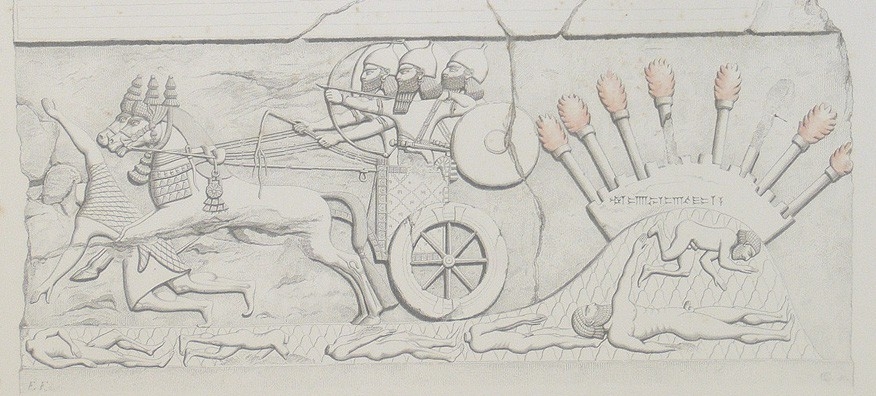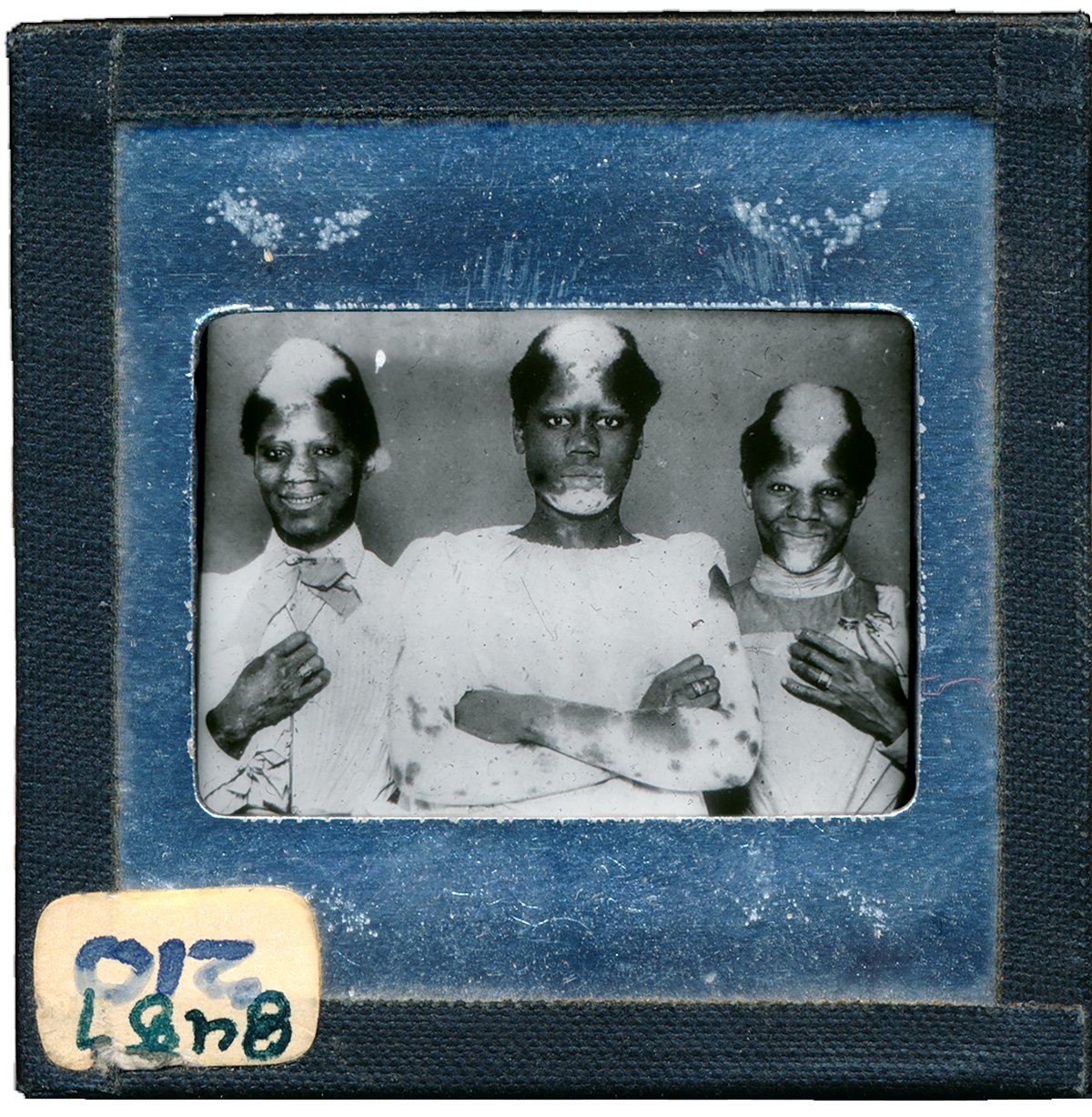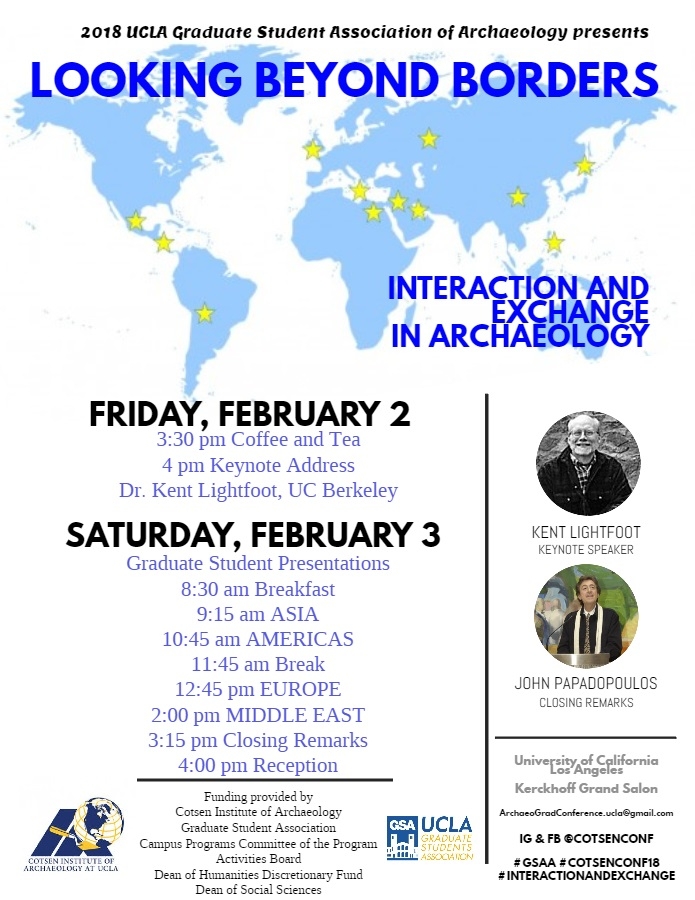Past Events
Interested in Cotsen events? Sign up for our mailing list.Speaker: Dr. Justin Walsh, Associate Professor, Department of Art History and Archaeology, Chapman University
The archaeology of human activity in space has been conceptualized since the 1990’s. Early work included definition of the parameters of the field, identification of subject material and sites, development of methodologies, and integration of common terrestrial archaeology activities such as cultural resource management and heritage protection into space archaeology. More rarely, but no less significantly, there have been research projects carried out by academic archaeologists as part of efforts to push the envelope of “the possible” in archaeological practice.This lecture will begin by outlining the history of space archaeology to date and contextualizing it within developments in the field of contemporary archaeology more generally. The author will then describe how they are undertaking the first archaeological investigation of a permanent habitation site in space: the International Space Station. The ISS Archaeological Project (ISSAP; https://issarchaeology.org) is applying the latest technological tools, including machine learning and crowd sourcing techniques, to classifying data from millions of images depicting life on board the space station during the last 17 years. This information will be used to map patterns of astronaut presence and absence in various locations, and the associations between crew, objects, and spaces on ISS. The results will enable a better understanding of how a society and culture forms on a spacecraft, and improve life during long-duration missions.
Contact Matthew Swanson
Email mswanson@ioa.ucla.edu
Phone
Speaker: Dr. Jennifer Meanwell, Lecturer, Department of Materials Science and Engineering, MIT
Copper and copper alloy artifacts were valued commodities at the Postclassic period (AD 1150-1500) Maya capital of Mayapán, and are found as a variety of luxury items, most commonly small ornamental bells. Due to the lack of ore deposits near Mayapán, metal must have been imported from elsewhere in Mesoamerica, entering as a raw material for shaping into desired objects or as already finished goods. As at other Maya sites, the assemblage of metal objects at Mayapán favors common commodities such as bells, tweezers, rings, and miniature axes, but the high frequency of casting errors and the unusual preference for miniaturized bells suggest local production of desired objects using re-cast metals. The past two decades of excavation at the site has unearthed a small but growing assemblage of ceramic fragments that seem to have served as remelting crucibles and as metallurgical molds for casting.
Our ongoing analysis of an exported sample of metallurgical ceramics investigates the raw materials used in manufacture, the modes of production, and the parameters of their use. We investigate the metallurgical ceramics using a variety of analytical tools, specifically ceramic petrography, electron microscopy, and chemical analyses, to demonstrate that these ceramics were used in metallurgical activities and to gain insight into their production and functionality. These highly specialized ceramic materials seem to have been produced using specific raw materials and pastes required by the intense heat and reducing atmosphere required of metallurgical production. This investigation provides insight into the localized pyrotechnical solutions developed by Mayapán’s metallurgical specialists to meet the demands of high-temperature crafting activity.
Contact Matthew Swanson
Email mswanson@ioa.ucla.edu
Phone
Contact
Email archaeogradconference.ucla@gmail.com
Phone
Speaker: Dr. Sarah Beckmann, Visiting Lecturer, Department of Classics, UCLA
Over the last generation, scholarly attention towards the production of sculpture in the late antique period (ca. 250 – 550 CE) has rekindled interest in the villa of Chiragan (Haute-Garonne, Aquitaine). Since its excavation in the 19th century, Chiragan has been heralded for its statuary collection, which remains the largest extant assemblage of marble sculptures securely associated with a private context. Among the finds are a number of late antique sculptures that were ostensibly made in eastern workshops: several portraits, small scale mythological statuettes, and multiple relief series. My paper focuses on this latter genre and suggests that these under-synthesized reliefs have much to add to our understanding both of the villa of Chiragan and the marble statuary habit of late Roman villas in southern Aquitaine.

Contact Matthew Swanson
Email mswanson@ioa.ucla.edu
Phone 310-825-4169
Speaker: Dr. David Fredrick, Associate Professor, Department of Classical Studies, University of Arkansas
3:00pm -- Panel Discussion on Critical Archaeological Gaming with Chris Johanson, Demetri Terzopoulos, Eddo Stern, and Lisa Snyder
4:00pm -- Reception
5:00pm -- David Fredrick Lecture: Data Games: Cognitive Mapping in Ancient Pompeii

Contact Matthew Swanson
Email mswanson@ioa.ucla.edu
Phone
This workshop focuses on the design of archaeological games that entice users to engage with archaeological skills, methods, questions and results. What are possible goals of such games, and how can these be reached through narratives, interactive mechanics and visual, aural and motive stimulants.
Beyond providing exercises in archaeological approaches, can emergent gameplay have a significant heuristic function? If so, what are the requirements for availability and quality of data, player choice and player skill development?
View the workshop program for details on the talks and activities. Guests are invited to join in-person or remotely view and participate in the workshop on Zoom: https://ucla.zoom.us/j/631730989
Image credit: Screenshot from “Deadfall” https://www.kotaku.com.au/2013/06/its-a-global-archeological-adventure-i...
PROGRAM
Thursday, January 25
10.00-10.15 Willeke Wendrich -- Welcome and purpose of the workshop
10.15-11.00 Tara Copplestone -- Rethinking Archaeology Through Game Design
11.00-11.15 coffee break
11.15-12.00 Erik Champion -- The Sin of Completeness versus the Lure of Fantasy in Contested Possibility-Spaces
12.00 – 1.00 Lunch Break
1.00-1.45 Willeke Wendrich -- Walking through Empty Buildings, Everybody Wears the Same Shoes
1.45-2.30 Hannah Scates Kettler -- Jumping into the Animus: Revisiting old video games to create new ones
2.30-3.15 David Fredrick -- Secrets in the Garden: Modeling Vulnerability and Information Exchange in the House of Octavius Quartio
3.15-3.30 Coffee break
4.15-5.00 Rosa Tamborrino -- The sense of Time in Videogames: Fragments and Lack of Dynamics in Historical Environment Reconstructions
Friday, January 26
10.00 – 12.00 Demonstrations in the Digital Archaeology Lab (Fowler A163)
12.00 – 1.00 lunch break
1.00- 3.00 Discussion: setting the agenda and follow up (Fowler A222)
3.00 pm Friday Seminar: Panel Discussion on Critical Archaeological Gaming: Chris Johanson, Demetri Terzopoulos, Eddo Stern, Lisa Snyder
4.00 pm Reception
5.00 pm Public Lecture by David Fredrick Data Games: Cognitive Mapping in Ancient Pompeii
Contact Deidre Whitmore
Email dal@ioa.ucla.edu
Phone
Speaker: Dr. Ali Mousavi, Lecturer, Department of Near Eastern Languages and Cultures, UCLA
The World Heritage site of Pasargadae, in southern Iran, is the first dynastic center of the Achaemenid Empire in the 6th century B.C. Pasargadae’s palaces, gardens and the mausoleum of Cyrus the Great are outstanding examples of the first phase of royal Achaemenid art and architecture. The ruins of a solitary stone tower, known by the local name of Zendan-e Suleiman (prison of Solomon), dominates the Palace area at Pasargadae. The function of this tower and its counterpart at Naqsh-e Rustam, near Persepolis, has been the object of various studies. The towers, however, defy any convincing interpretation. The results of recent excavations at Pasargadae seem to shed some light on the function of these towers.

Contact Mathew Swanson
Email mswanson@ioa.ucla.edu
Phone
This will be a series of two 30-minute lectures
"Perception in Palatial Architecture: The Example of the Tupkish Palace at Tell Mozan" by Dr. Federico Buccellati
Space, as an expression of the architectural volumes expressed in Mesopotamian palatial architecture, can seem an abstract, distant concept, visible but not understood, and lacking interaction. These volumes, however, carry a deeper meaning: they conditioned and were affected by the daily life of the individuals who used these spaces. The aim is to go beyond the factuality of the data, important though that is, and to recover, through arguable and documentable procedures, the human perception. This perceptual impact encompasses not only the sense of sight, but also sound, smell and touch. The archaeological record gives only partial evidence, as is always the case, but this is often enough to draw meaningful conclusions.
"Architecture Between Bricks, Images and Words" by Dr. Maria Gabriella Micale
The centrality of architecture in the Mesopotamian worldview is reflected in both myth and reality. The presented research is a study of form and function of architectural representation and description. It analyzes the representation of Assyrian architecture by means of an innovative theoretical approach, which identifies features and functions of the occurrence of architecture in both images and texts, also in the light of the broader Mesopotamian culture. Contrary to the traditional scientific approach to images, which considers them mere reproductions of the physical built space, the project aims at defining the role of the textual description of architecture in the construction of visual imagery, the relationship among the different traditions (architectural, iconographic, and textual), and the paths of their reciprocal influences.

Contact Matthew Swanson
Email mswanson@ioa.ucla.edu
Phone
Speaker: Dr. Ioanna Kakoulli, Professor, Department of Materials Science and Engineering, UCLA
Fayum portraits are paintings mainly on wooden support reflecting Greek painting traditions and Egyptian funerary practices. These paintings are naturalistic portraits of the deceased and provide a snapshot of Greek civic life and customs in Egypt during the Ptolemaic and Roman rule. Non-invasive and non-destructive evaluation (NDE) of these portraits from the macro to the molecular length scale using combined imaging and spectroscopic techniques supported label-free fingerprint identification of pigments and binding media revealing raw materials selection, production technology and the operational sequences (chaîne opératoire) of the processes associated with the making of the painting. Results from the analyses integrating hyperspectral cubes in reflectance luminescence and X-ray fluorescence (XRF) and forensic imaging investigations combined with fiber-optic reflectance spectroscopy (FORS) and portable XRF, indicated the use of a variety of natural and synthetic organic, inorganic and composite pigments mixed with melted beeswax in ‘encaustic’ [εγκαυστική] painting technique. The significance of this research is twofold: 1) research has been conducted without the need to take any samples and 2) results from the analyses revealed key information on the fashion and practices in Egypt during the Greek and Roman period. For example, the production of the green pigment, a synthetic organic-inorganic complex, giving the green color to the ‘gemstones’ of the necklaces in women’s portraits, is similar to the processes in alchemical manuals of the third century AD, describing a method how to color rock-crystals green, in imitation of precious stones. Similarly, the pigment madder lake used to paint the red-purple garments in the portraits replicates technology employed for the production of mordanted dyes to tint yarns for the textile ‘industry’. These results further illustrate the close affinities and interconnections between the various ‘chemical arts’, such as mining, metallurgy, corrosion and dyeing, to the art of painting and how the cultural and socio-political milieu in Egypt during the Greek and Roman period, with philosophies driving experimentation, influenced material choices and processes involved for the production and use of pigments in art.
Contact Matthew Swanson
Email mswanson@ioa.ucla.edu
Phone
Speaker: Dr. Doug Bailey, Professor, Department of Anthropology, San Francisco State University
What happens when people attempt to discard and destroy a museum archive that contains many thousands of visual and material objects? In this workshop, we discuss the politics, potential, and violence of archive objects (specifically a cache of over 1200, 35-mm transparencies from the mid-late 20th century. What lives do they live? Are they passive and neutral objects resting peacefully in an institution's collection? Are they active material things? If the latter, then what affect do they have, what energies and essences do they constitute, what is their present and their future, where should they go, and what should they do?

Contact Matthew Swanson
Email mswanson@ioa.ucla.edu
Phone
- ‹ previous
- 35 of 50
- next ›



